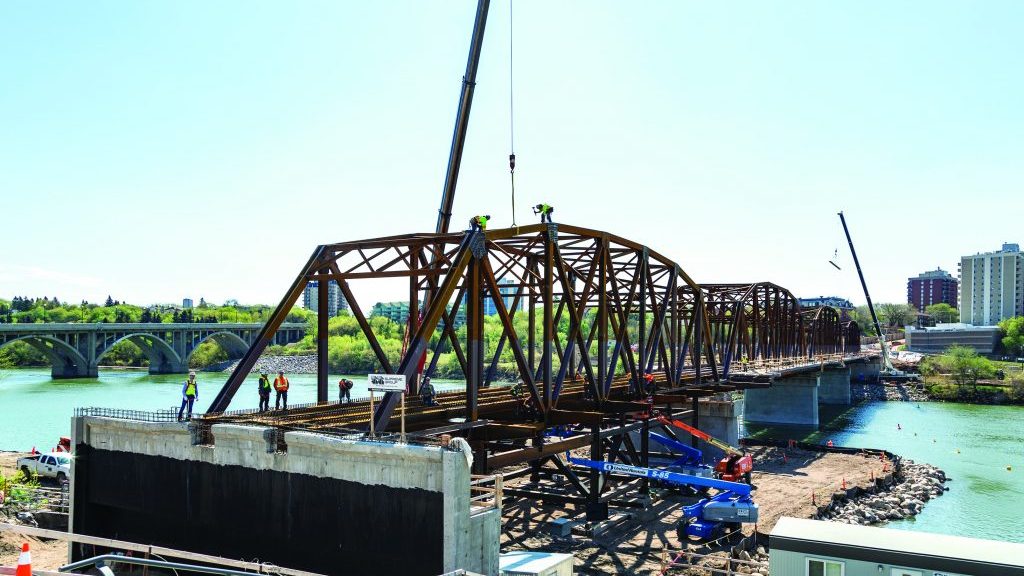Although it is located in the middle of the landlocked prairies, Saskatoon is still the City of Bridges.
The first of the city’s eight bridges, the Traffic Bridge, opened in 1907.
Before the Traffic Bridge was built, a ferry and a railway bridge were the only ways to cross the river from Saskatoon to what was then the separate community of Nutana.
The Traffic Bridge, also known as the Victoria Bridge, performed yeoman service to the growing city for more than 100 years. Old age finally caught up with it, however, and it was closed to traffic in 2010.
But you can’t keep a good bridge down.
Work on a new Traffic Bridge began at the end of 2015, with completion slated for October 2018.
The story of the old and new Saskatoon Traffic Bridge was recounted at the Canadian Institute of Steel Construction Canadian Steel Conference, which took place Sept. 19-21, 2018 in Halifax, N.S.
David Fritz, director of project solutions of Saskatoon’s Supreme Group, which supplied, fabricated and installed the steel for the new bridge, described the project, including the differences and similarities between building a steel bridge early in the 20th century and in the third decade of the 21st century.
“Both bridges are Parker trusses, one of the oldest types of bridge design,” said Fritz. “The city decided to copy the original design, in the interest of historical continuity.”
The original bridge, which was very narrow, was built for horse and buggy and foot traffic. Tracks for street cars were added in 1922.
The new Traffic Bridge, when it is completed and open to traffic in the fall, will be a four-span arrangement, with reinforced concrete piers in the river.
Although the geometry of the new bridge is similar to the old, it is slightly wider and taller, in order to accommodate wider traffic lanes.
It also features wider pathways for cyclists and pedestrians on both sides, and overhead clearance for emergency vehicles.
The Traffic Bridge will be able to accommodate an average of 11,000 vehicles daily, with the capacity to handle over 20,000 vehicles per day.
Supreme studied the steel from the old Traffic Bridge before it specified the building materials for the new bridge.
“After the old bridge was demolished, Supreme tested its steel,” said Fritz. “We found that the steel above the bridge deck was still in good shape, but the steel below deck had suffered from salt corrosion.”
To protect it from salt damage, the new bridge is made of conventional weathering steel with a protective coating on steel in the splash zone.
The result will be a two-tone colour between the lower and upper portions of the structure that will remain until a thin surface layer can form on the exposed portions of the weathering steel. Eventually the entire bridge will turn brown.
Fritz says the construction methods used on both bridges are quite similar. “When the original bridge was built, wood shoring was put in place first, then the steel bridge built on top of the shoring, and then the shoring was removed,” he said. “A crane moved along the bridge as it was built.”
To build the new bridge, Graham Commuter Partners, the general contractor on the project, built a berm in the river and the construction crane operated from it.
The project’s location, in the South Saskatchewan River Valley, presented a few challenges, says Fritz.
“The river flows very quickly, and we needed to always keep a sharp eye on the berm, so that it remained strong and intact,” said Fritz.
The numerous environmental regulations on the use of the river required experienced administrative navigation.
“For example, we had to be careful not to disturb the fish in the river, especially during the spring spawning season,” said Fritz. “We had to stick very closely to our construction schedules and not go beyond them, for the sake of the fish.”
In addition, because the river valley holds and magnifies sound, and because people live on both sides of the river, the builders needed to be careful to keep noise to a minimum.
The replacement of the Traffic Bridge is part of Saskatoon’s Bridging to Tomorrow Project, which also includes the construction of the Chief Mistawasis Bridge and the extension of Central Avenue and McOrmond Drive.
Like the Traffic Bridge, the Chief Mistawasis Bridge and surrounding road infrastructure are slated for completion in October of 2018. The entire project was executed under a public-private partnership contract for which Graham Commuter Partners was formed.











Recent Comments